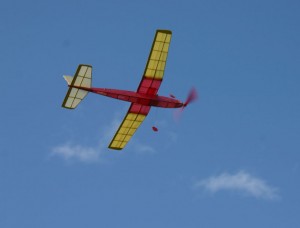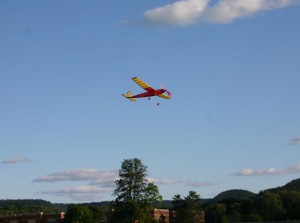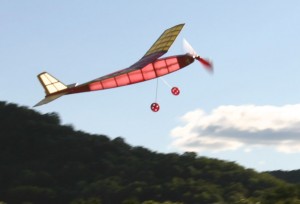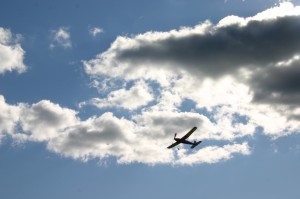The Guillow’s Fly Boy was the first of the Build-n-Fly series that I built although this is the last in the series and would be the hardest to construct. Having built model planes for many years I thought I could handle the construction. In this series of planes after the initial hand launch glider, the rubber powered models add increasingly larger number of pieces in the structure. Fly Boy is the only plane in the series that has a completely built-up fuselage structure.
This is also the largest plane in the series with a 21” wingspan and a length of 19 ¼”. The longer plane makes for a stable plane but it is easy to have a plane that is tail heavy. My plane did require some clay on the nose to balance correctly. To reduce the weight of the plane, I used my own colored tissue and drilled holes in the plastic wheels. I used dowels and small rubber bands to mount the wing also instead of one big rubber band over the wing and fuselage as shown on the plans.
As typical of designs of rubber powered model planes of many years ago, there a large number of tiny sticks making up the fuselage. Nothing really hard about this but there will be a lot of cutting and gluing needed. The wing is a 3-panel design with multiple spars in the wing.
Not sure what came in the kit for rubber but I used 3/16” Tan SS rubber. This will give the plane a long gentle climb and nice cruise. It is not going to take it up at a near vertical angle. Once adjusted for climb and turn the Fly Boy should give consistent flights that are beautiful to watch.
Bill Kuhl
Video of Fly Boy and Cloud Buster: E0FwV4_TcV4





I am building this kit as a first time builder. How do you wind the rubber band, the instructions were very vague.
Hi John.
Word Press has stopped notifying me of comments, so I didn’t see this until just now when I logged in to do an edit. I didn’t write this article, but I can answer your question.
Generally you will want a winder and a stooge. You will also want to lube and stretch wind the motor. The motor should have an O-ring in it. There are other posts on EndlessLift showing that about other airplanes. See the ones on making rubber motors and using a foot stooge. You can search the words ‘winding’, ‘stooge’ and ‘winder’.
Winders have been made from hand drills. Make a hook from stout wire and clamp it in the chuck. Just be sure it can not pull out, because you will be stretching the rubber and if the hook pulls out, you will have a projectile.
You can buy winders from several of the suppliers in our supplier list. The winder puts several turns into the rubber for each turn of the crank. 10:1 is a convenient ratio. I count by 10s.
In the old days, the stooge was your flying buddy. He held the plane while you stretched out the motor and put in the winds. The winder hook goes into the O-ring. When you get done winding, you tightly grip the O-ring and transfer it from the winder hook to the prop hook. There are commercially available stooges and many modelers build their own. Often it will have to be adapted to the particulars of your airplane.
You may find a local club where you can see planes being flown and learn the tricks if you search the club listings at the Academy of Model Aeronautics and the National Free Flight Society. Our genre is called free flight rubber power. You will want to find a club that practices that discipline.
This whole series used to belong to Comet. Comet called this one the Cloud Buster. You can see the plan on Outerzone, where you can also find an old ad showing the series. Guillow’s Cloud Buster used to be the old Comet Fly Boy. I wonder why they switched the names.